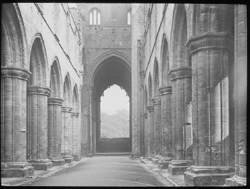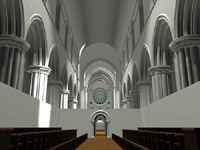 |
 |
 |
 |
 |
 |
 |
|
(3/8)
The east-end presbytery, the oldest part of the church, was unaisled and comprised two bays. It was set apart from the monks’ choir by several steps, emphasising that this was the liturgical heart of the church and the most sacred part of the precinct - it was here that the High Altar was situated, the Mass celebrated and Communion received. The High Altar stood slightly apart from the east end wall and was made of white freestone; the altar survived until the early eighteenth century when it was reputedly destroyed by three localmen from Bramley. A light before the High Altar burned throughout the day and night; this was financed by a grant in 1159 from the abbey’s founder, Henry de Lacy.(2) The altar was otherwise simply adorned or, at least in the early days, for an ornate alabaster altarpiece may have later hung above it. An altarpiece showing the Entombment of Christ, with eight gilded statues attached, said to have been from Kirkstall, was stored until the late seventeenth century at Horsforth Hall but has since been lost. To the south of the High Altar a canopied seat, the sedilia, was carved in the wall. It was here that the officiating clergy sat upon a stone bench, which was later replaced by a timber one. Remains of the sedilia show quite clearly that it extended from the floor to form a wide semi-circular arch. Two niches in the wall adjacent to the sedilia were for the piscina, a drain where the holy vessels were washed, and the credence table, where the chalice was prepared for the altar. The Cistercians strictly prohibited the use of gold, silver and jewelled vessels yet we know that Kirkstall had a golden chalice in the twelfth century, for this was amongst the abbey’s treasures that Abbot Ralph (1182-90 ) gave to Henry II, in an attempt to win the king’s favour and recover the abbey’s lands at Micklethewaite.(3) At Lent the High Altar was screened off from the rest of the church by a large curtain, the Lenten veil, and the holes from which this was hung can still be seen at Kirkstall. At Abbey Dore in Herefordshire the actual hooks from which the curtain was hung have survived.
|

